With so many different types of rigging gear out in the field, safety and production personnel have to stay laser-focused on understanding the inspection requirements and frequencies for their lifting equipment. Each type of lifting sling—including chain slings, metal mesh slings, wire rope slings, synthetic web slings, and synthetic roundslings—all have their own removal from service criteria, sling tag requirements, and inspection frequencies.
At Mazzella, we understand the amount of effort and coordination it can take to stay in compliance with OSHA and ASME’s industry standards. We have a dedicated business unit made up of highly-trained and qualified employees that focuses only on sling and rigging equipment inspections, industry compliance, and sling testing and repair.
A well-thought-out chain sling inspection program can help prevent industry compliance issues, keep your workers safe, and extend the life of your lifting equipment. Here are some tips and best practices for safely getting the most out of your alloy chain slings.
Who Performs Chain Sling Inspections and How Often Do They Occur?
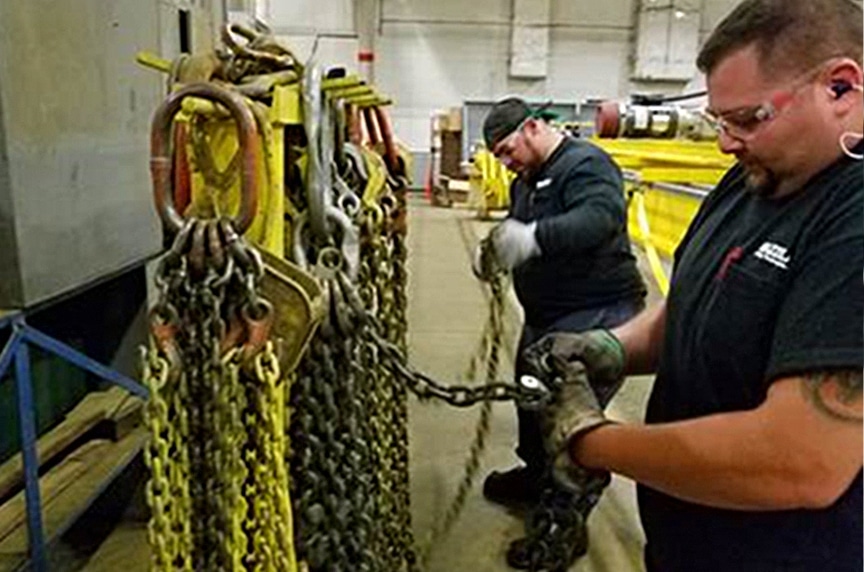
All inspections shall be performed by a Designated Person with any deficiencies further examined by a Qualified Person to identify hazards and determine what additional steps need to be taken to address the hazard.
There are two industry standards that exist to provide the end-user with guidelines for inspection and criteria that warrants removal from service: OSHA 1910.184 and ASME B30.9.
Initial Inspection (prior to initial use)
Best practice is to inspect any synthetic rope sling upon receiving it from the manufacturer. Double-check the sling identification to make sure it’s what you ordered and that the rated capacity meets all of your project specifications and lifting requirements.
Frequent Inspection (daily or prior to use)
Designate a Competent Person to perform a daily visual inspection of slings and all fastenings and attachments for damage, defects, or deformities. The inspector should also make sure that the alloy chain sling that was selected meets the specific job requirements it’s being used for.
However, users can’t rely on a once-a-day inspection if the sling is used multiple times throughout the day. Shock loads, severe angles, edges, and excessive heat can quickly cause damage to the material, so best practice is to perform a visual inspection prior to each use.
Periodic Inspection
A documented periodic inspection is performed by either a professional inspection provider, or by a Qualified Person, every 12 months (at a minimum) and monthly to quarterly in more severe service conditions. The following are all determining factors in scheduling the frequency of a periodic inspection:
- Frequency of use
- Severity of service conditions
- Nature of the lifts being performed
- Experience gained on the service life of alloy chain slings used in similar applications
ASME provides these additional periodic inspection guidelines based on the service of the alloy chain sling:
- Normal Service – Yearly
- Severe Service – Monthly to Quarterly
- Special Service – As recommended by a Qualified Person
Depending on the severity of the operating environment and frequency of use, your business may decide that a thorough sling inspection should occur more often than the minimum yearly requirement.
Periodic inspections are required to be documented per ASME B30.9 and records retained. The employer is required to maintain a record of the most recent thorough inspection and per OSHA 1910.184, a record of each sling that was inspected.
Failure to maintain and retain inspection records is one of the most common issues we see that can prevent a company from reaching full OSHA compliance.
All inspections shall be performed by a Designated Person with any deficiencies further examined by a Qualified Person to identify hazards and determine what additional steps need to be taken to address the hazard.
There are two industry standards that exist to provide the end-user with guidelines for inspection and criteria that warrants removal from service: OSHA 1910.184 and ASME B30.9.
What Is Required on a Chain Sling Identification Tag?
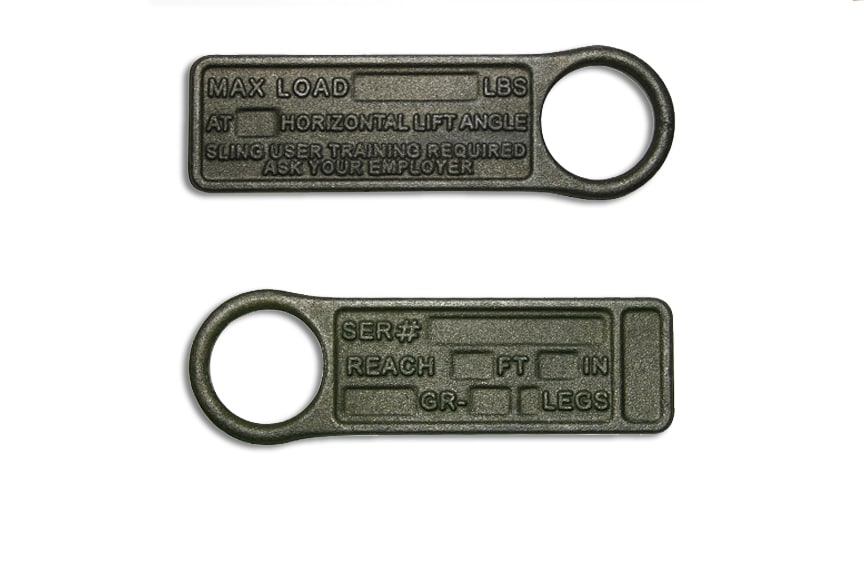
When using a chain for overhead lifting, the user must make sure that the grade of chain is composed of alloy steel as opposed to carbon steel, and that the sling has an identification tag. If the chain sling doesn’t meet these requirements, the user must not use it for overhead lifting. Size for size, alloy chain has greater strength than carbon chain, and alloy is the only chain that manufacturers recommend for typical overhead lifting. If the chain is alloy, the sling identification tag will designate it as being alloy.
Per ASME B30.9, the chain sling shall be marked to include:
- Name or trademark of manufacturer
- Grade
- Nominal chain size
- Number of legs
- Rated load for the type of hitch(es) used and the angle upon which it is based
- Length (Reach) of the sling
- Individual sling identification (e.g., serial numbers)
If the tag is missing or illegible, the inspector should remove the sling from service and send it to an authorized chain repair facility for current or updated certification, tagging, and testing.
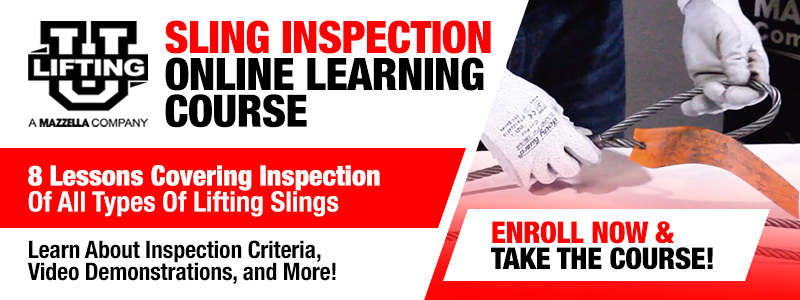
What Environments or Lifting Applications Can Prematurely Damage Chain Slings?
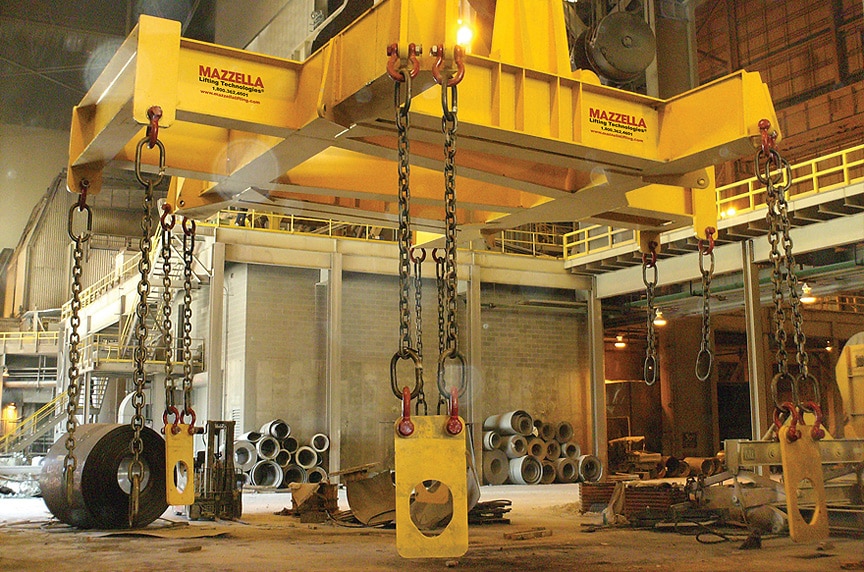
Whether you’re doing rigging inspections in-house or working with a third-party rigging inspection service, it’s very important for the inspector to understand what abuse the chain is seeing and inspect it accordingly.
Often times, sling abuse is inherent with a given application. However, by knowing what types of applications cause premature chain wear and even sling failure, the rigger can be in a better position to know what to look for when inspecting slings.
With regard to inspection criteria, chain damage typically falls into one of five categories and critical damage will be obvious to a properly trained inspector. These categories include:
- Wear
- Nicks and gouges
- Localized bending
- Shearing
- Stretch
For example, overload normally causes chain stretch. The overload can be the result of the load itself weighing more than the sling’s capacity.
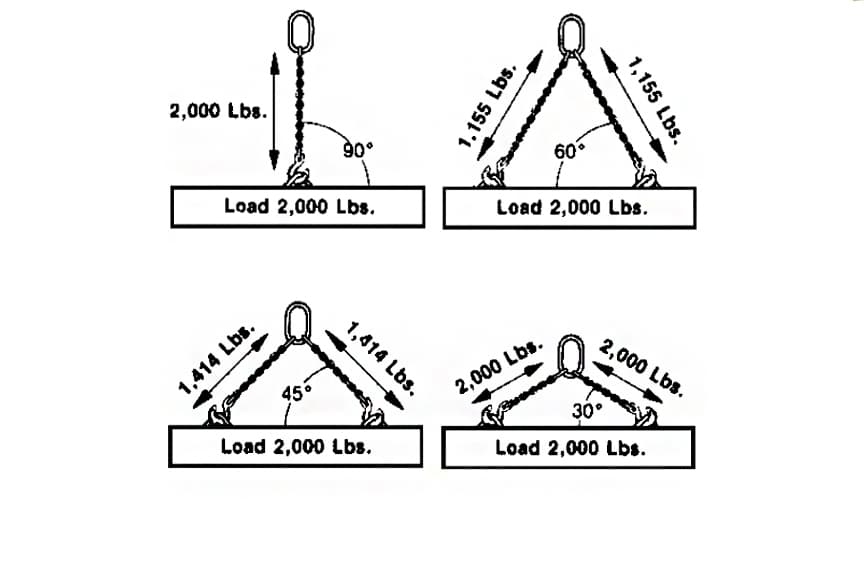
Severe angles can also result in a sling being overloaded. Alloy chain sling charts have rated capacities at 30°, 45°, and 60° angles. The typical angle is 60°. Normally two, three, and four leg chains have three ratings for a specified number of pounds at 60°. The sling identification tag also states the rated capacity for the specified sling angle. Be aware that sling angles greatly affect the tension on each leg of the sling. The farther apart the legs of the sling are spread, the more tension there is on the sling legs.
A good rule of thumb is to measure the distance between the hook-up points, and have the sling legs measure at least that long.
For example, if the distance between the hook-up points measures 10 feet, then the sling legs should be at least 10 feet long. This practice ensures that the two leg lengths and the distance between the hook-up points form an equilateral triangle resulting in the sling angles being 60°.
If the application dictates sling angles less than 60°, then the user needs to choose the correct size sling to allow for the more severe angle. In any case, never use a sling at angles less than 30°. This concept for sling angles and leg lengths applies to all sling types—not just chain slings.
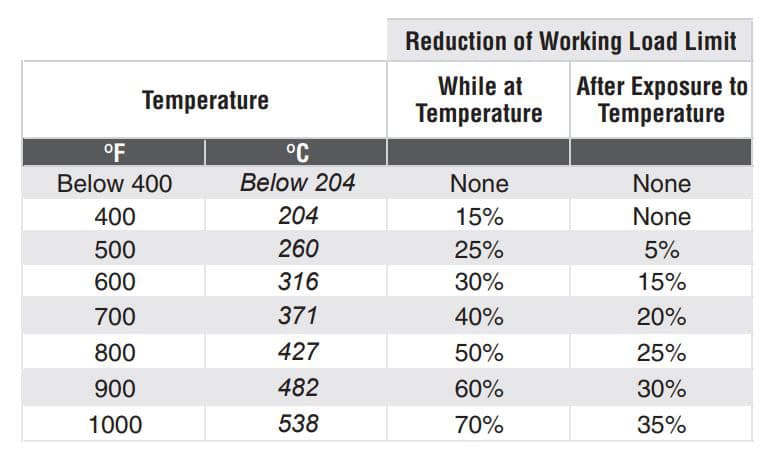
In applications involving high heat, the user must pay attention to the amount of direct heat that the chain sees. Often, direct heat results in the chain turning a blueish color. The user should consult the chain manufacturer’s capacity reduction charts relating to heat. In addition, be aware of any damage caused by weld splatter or molten metal being splashed on the slings.
In applications that involve lifting loads with rough or sharp edges, wear pads should be used on unprotected corners—otherwise the chain is susceptible to nicks, gouges, and crushed or bent links.
Wrapping it Up
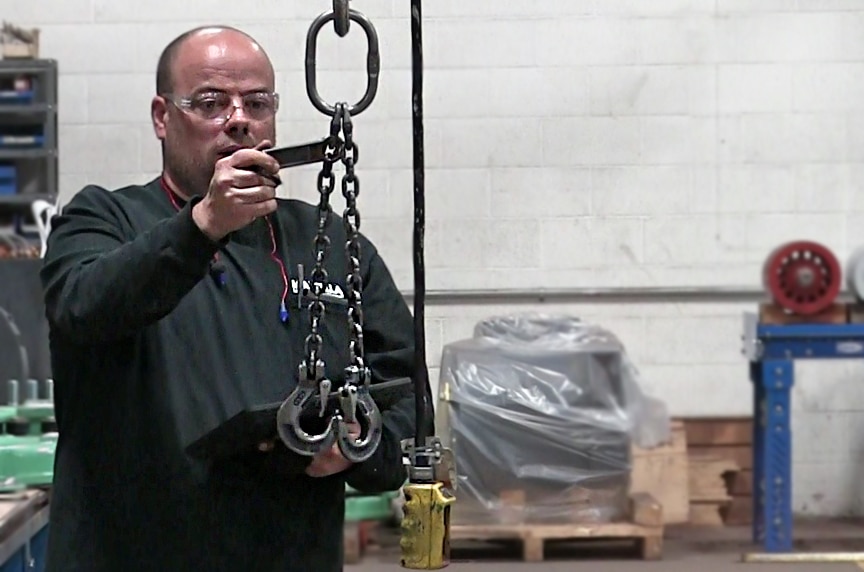
In conclusion, be sure to designate a qualified inspector to perform sling inspections on a routine basis. Also, provide training to your sling users so that they may learn or refresh their knowledge on sling usage and inspection.
Follow these best practices for sling use and inspection:
- Do know the weight of the load
- Do determine the type of hitch
- Do choose the correct size and style sling
- Do use the longest sling possible and practical
- Do stand clear of the load
- Do lift evenly and smoothly
- Do visually examine slings each time before use
- Do discard or red tag worn and damaged slings
- Do store properly
- Do use pads around sharp corners to prevent sling damage
- Do have slings repaired or modified only at a qualified sling service center
At Mazzella, we offer a variety of services including site assessments, rigging and crane operator training, sling inspection and repairs, overhead crane inspections and so much more. Our rigging inspection program is its own dedicated business unit with a team of inspectors that are certified through Industrial Training International to meet OSHA 1910.184 and ASME B30.9 requirements for sling inspection.
If you’re interested in learning more about our rigging inspection program and how we can help keep you in compliance with OSHA and ASME standards, contact us today to schedule a consultation or site assessment.
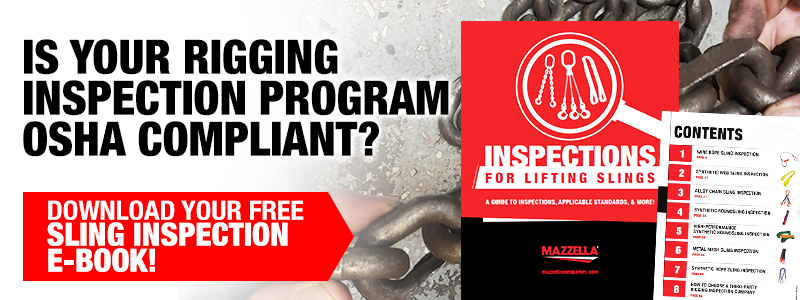

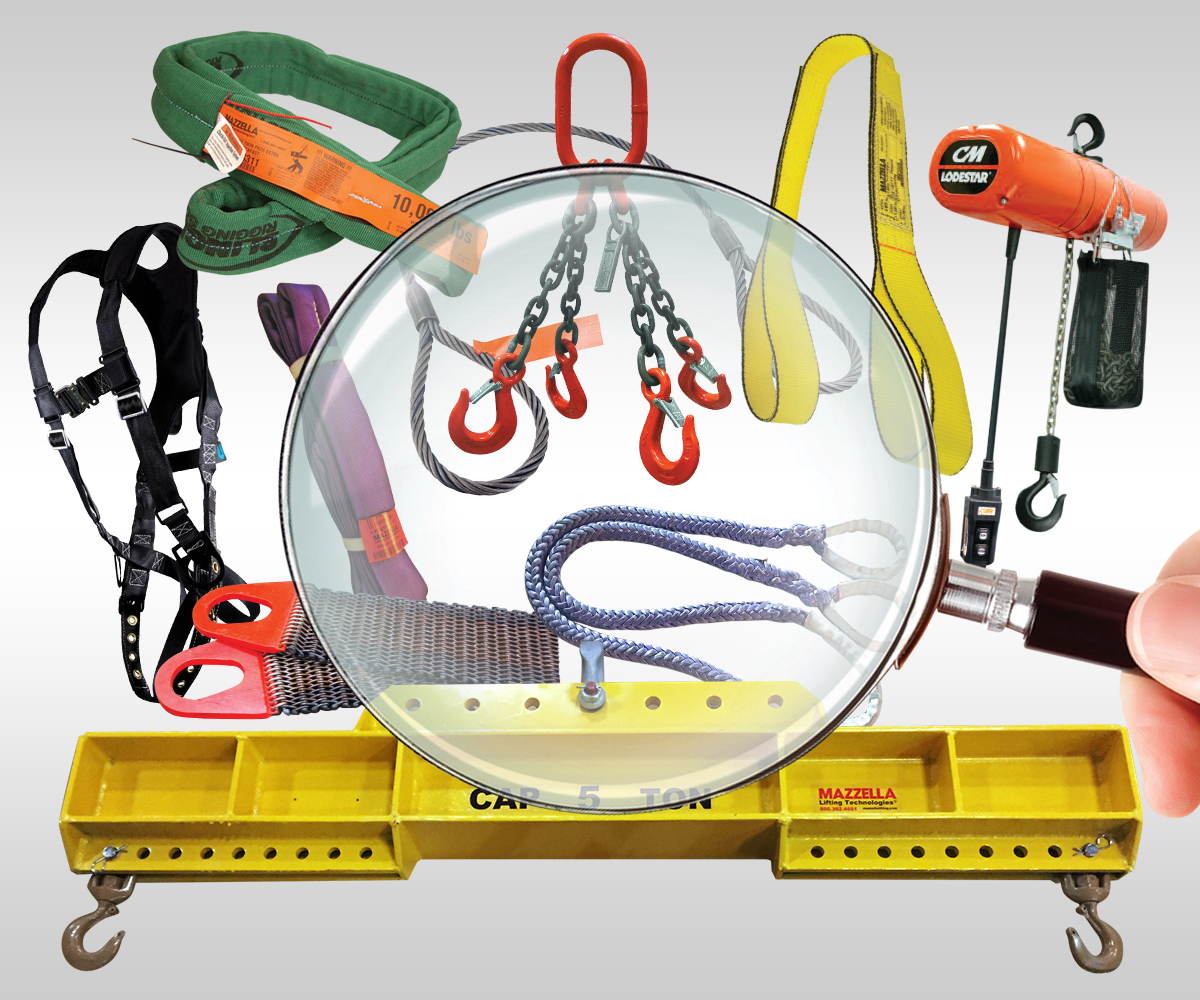
Rigging Inspection Services
OSHA 1910.184, ASME B30.9, B30.20, B30.26, & ANSI Z359 require periodic, documented inspections on slings, rigging hardware, lifting devices, and fall protection every 12 months, at minimum, and monthly to quarterly in more severe service conditions.
Call us at 800.362.4601 or click here if you need inspections for slings, rigging hardware, lifting devices, or fall protection!
Copyright 2017. Mazzella Companies.
